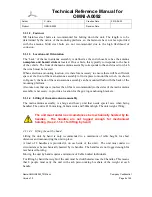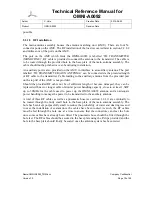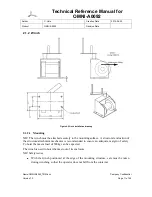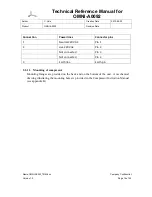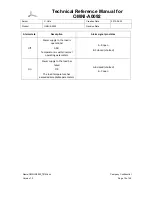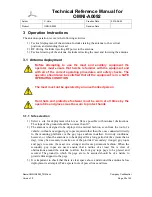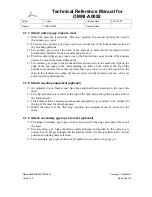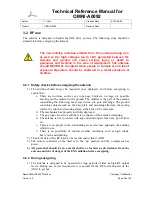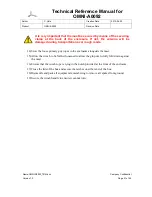
Technical Reference Manual for
OMNI-A0092
Author
C. Vale
Creation Date
2010-04-29
Product
OMNI-A0092
Revision Date
Name:OMNI-A0092_TRM.doc
Company Confidential
Version 1.0
Page 21 of 55
3.1.2 Check weather conditions
1)
Before deploying the antenna, check the weather conditions. It is dangerous to attempt
a deployment when it is too windy. It is recommended that that deployment should
occur when wind speeds are no higher than 60 km/hr.
The antenna is not designed to be deployed in high wind or at extreme
tilt angles. Attempting deployment under such circumstances could
result in structural failure and lead to injury or death.
2)
In addition to wind, check for signs of lightning and rain. The antenna can operate in
light rain. But heavy rain may short out its operation. The antenna should never be
deployed when there is lightning as it may well attract a strike.
Be very careful of leaving the antenna deployed in a lightning storm.
Due to the antenna’s height, there is a very high likely hood of it
attracting a direct strike, which could cause damage to equipment and
injury or death to nearby personnel.
3.1.3 Prepare for secondary guy ropes (optional)
1)
If it is desired to make use of the longer secondary guy ropes for operation in high
winds, then the field should be spiked with the four guy rope pegs provided.
2)
The pegs are best located as far away from the antenna site as possible to allow the
maximum 12m of the guy ropes to be utilised. For use in high winds the pegs should
be a minimum of 6m away from the point where the centre of the deployed antenna
intersects with the ground.
3)
Ideally, the pegs should be located in the 12, 3, 6 and 9 o‟clock positions, where the
front of the antenna is in the 12 o‟clock orientation.
4)
Make use of the mallet provided to secure the pegs in the ground, ensuring that they
penetrate to a depth of at least 30cm and are secure.
3.1.4 Open the enclosure
1)
Loosen the two latches on either end of the box.
2)
Open the lids of the box.


